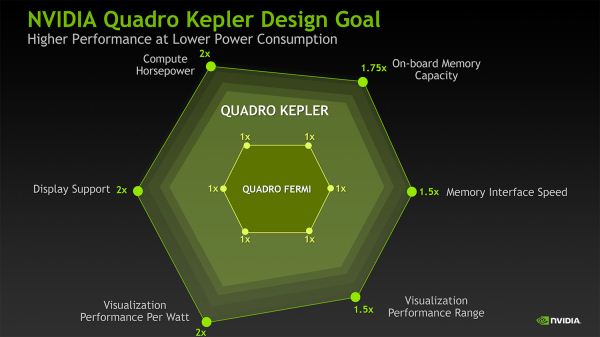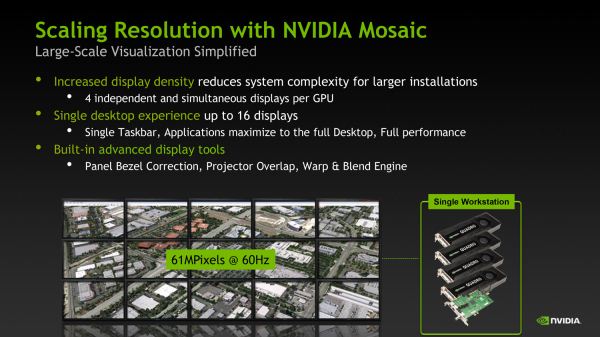NVIDIA Launches Quadro K4000, K2000, K2000D, & K600
by Ryan Smith on March 5, 2013 9:00 AM ESTBack in August of 2012 NVIDIA announced their first Kepler based Quadro part, the Quadro K5000. Based on NVIDIA’s at the time leading GK104 GPU, K5000 was the customary generational update to the workstation-focused Quadro family, bringing to the Quadro family Kepler generation features such as support for 4 monitors, NVIDIA’s NVENC video encoder, and of course greater rendering performance. However since its launch the K5000 has stood alone as the only Kepler based desktop Quadro card, with the older Fermi based products filling out the rest of the Quadro family. Today that will finally be changing as NVIDIA fleshes out the rest of the Quadro lineup with new Kepler based parts.
Altogether NVIDIA will be launching 4 new Quadro cards, intending to fill out the lower performance, higher volume market segments below the $2,250 K5000. These cards will be the K4000, the K2000, the K2000D, and the K600.
| Quadro K5000 | Quadro K4000 | Quadro K2000 | Quadro K600 | |
| Stream Processors | 1536 | 768 | 384 | 192 |
| Texture Units | 128 | 64 | 32 | 16 |
| ROPs | 32 | 24 | 16 | 16 |
| Core Clock | ~700MHz | ~800MHz | ~950MHz | ~875MHz |
| Memory Clock | 5.4GHz GDDR5 | 5.6GHz GDDR5 | 4GHz GDDR5 | 1.8GHz DDR3? |
| Memory Bus Width | 256-bit | 192-bit | 128-bit | 128-bit? |
| Frame Buffer | 4GB | 3GB | 2GB | 1GB |
| FP64 | 1/24 FP32 | 1/24 FP32 | 1/24 FP32 | 1/24 FP32 |
| Max Power | 122W | 80W | 51W | 41W |
| GPU | GK104 | GK106 | GK107 | GK107 |
| Architecture | Kepler | Kepler | Kepler | Kepler |
| Transistor Count | 3.5B | 2.54B | 1.3B | 1.3B |
| Manufacturing Process | TSMC 28nm | TSMC 28nm | TSMC 28nm | TSMC 28nm |
| MSRP | $2,249 | $1,269 | $599 | $199 |
Just as how the K5000 was the direct successor of the Fermi based Quadro 5000, these new cards are the direct successors of their respective Fermi counterparts, and will be occupying roughly the same market segments. At $1,269 will be the GK106 based K4000, which combines 768 CUDA cores with 3GB of RAM. Below that is the K2000 at $599, a GK107 based part packing 384 CUDA cores and 2GB of RAM. K2000 will come in two variants, a standard variant with 2 DisplayPorts and 1 DL-DVI port, and the K2000D which flips that for 2 DL-DVI ports and 1 mini-DisplayPort. Finally at $199 is a further cut down GK107 part, the K600, NVIDIA’s entry-level Kepler Quadro card featuring 192 CUDA cores, 1GB of RAM, and 1 DisplayPort along with 1 DL-DVI port.
Similar to how the Fermi Quadro cards were handled, the Kepler Quadro cards are essentially stratified based on a mix of features and performance. Partial ECC support for example will not make it down to any of these new cards, while NVIDIA’s GPUDirect for Video technology is being made available on the K4000 and above, but not the K2000 or K600. Meanwhile relative to their Fermi predecessors performance has increased across the board, with the specific gains varying with the SKU and the resource needs of any given application.
Of course the big draw for the Kepler Quadro family is Kepler’s improved display controller, which adds support for DisplayPort 1.2, support for 4K displays, and at the same time doubles the number of displays that can be driven from 2 on Fermi to 4 on most Kepler cards. Like the K5000, the K4000 and K2000 will be able to drive up to 4 displays, but in an important difference, owing to their smaller profiles these cards will not feature 4 display outputs. Rather in a first for NVIDIA, they will be relying in DisplayPort 1.2’s MST/daisy-chaining functionality to drive 2+ monitors off a single DP output.
Similarly, with the increased number of supported displays per card NVIDIA has upgraded their Mosaic software to match Kepler’s capabilities, increasing the number of displays that can be part of a mosaic. Mosaic now supports 16 displays spread over 4 video cards, for 4 displays per video card.
Finally, as with the Fermi generation of Quadro cards, the Kepler generation of Quadro cards will be top-to-bottom Maximus enabled for blended graphics/compute tasks. This means any Kepler Quadro card can be paired with a Tesla K20 to offload compute onto the K20 in supported applications, freeing up the Quadro card for graphical tasks while boosting compute performance. Given the $3000+ price tag on a K20 we don’t expect to see very many environments using Maximus with the K600, but from what we’ve seen in the past, Quadro 2000 series cards have ended up being Maximus pairings for use in tasks where a Quadro card is being used to visualize Tesla results.
On a final note, unlike the K5000 this will be a hard launch, so K4000, K2000, and K600 cards will be available starting today. This goes for both retail add-in card sales and for pre-built OEM systems, with OEMs shipping systems equipped with NVIDIA’s latest Quadro cards as soon as today.

























22 Comments
View All Comments
mayankleoboy1 - Tuesday, March 5, 2013 - link
What is this feature ? I dont reeber reading this before.DuckieHo - Tuesday, March 5, 2013 - link
Other than the GK110, NVIDIA does not plan to have any lower priced, strong FP64 GPUs this round?DanNeely - Tuesday, March 5, 2013 - link
The 100/110 parts have always been the only high FP64 chips in nVidia's lineup. I'm surprised they aren't offering any Quadros with them yet. The chips huge size should provide them with lots of dies with several faulty core blocks; which nVidia's always used for most of their mid/upper range quadro cards in the past.Ktracho - Wednesday, March 6, 2013 - link
The Geforce Titan is less expensive than the Quadro K4000. If someone actually needs a strong FP64 GPU but can't afford the Titan, maybe a Fermi card will work.MojaMonkey - Tuesday, March 5, 2013 - link
I'm using a Lenovo S430 with an external thunderbolt graphics card. It's an external nVidia GTX 680.It's an option if you need a laptop on the go and also need desktop graphics when at home.
stunted1 - Tuesday, March 5, 2013 - link
Despite being new ASICs, I'm having a hard time understanding what is compelling about these products. I was looking for something more competitive. Based on link below, it looks like the FirePro cards offer more performance...http://www.youtube.com/watch?v=PhjCEDmU9jA
ShieTar - Wednesday, March 6, 2013 - link
As far as I remember, any comparison test between Quadro and FirePro over the last 3 years has shown a strong dependence on the specific software used for the benchmark, even more so than with consumer cards and games. So the FirePro is faster by 100% or 200% for some tasks, and slower by 80% for others.stunted1 - Wednesday, March 6, 2013 - link
My interest is SolidWorks specific, where I am seeing great FirePro performance (I have one, and use the application), and the video shows it too. Honestly, I can't speak to other applications, but if it is this much better in SolidWorks, I would expect similar advantages on other CAD applications using OpenGL (or not 80% less), but I'm not in a position to confirm that (with a card, or the applications).Regardless, I thought it was nice to see real application performance, vs. viewperf numbers, which seem to have no relationship with the application itself.
CeriseCogburn - Tuesday, March 12, 2013 - link
LOL - Yes amd fanboy, the card you bought is the best at everything. Now go bow to Abu Dhabi.CeriseCogburn - Tuesday, March 12, 2013 - link
Yeah, just like if you only want to do bitcoin, although if your evidence is a single youtube video, I'd say stay ignorant and happy.Just make certain you stay convinced because amd will be stomped again.
When it disappears soon, your "investment" support goes with it.